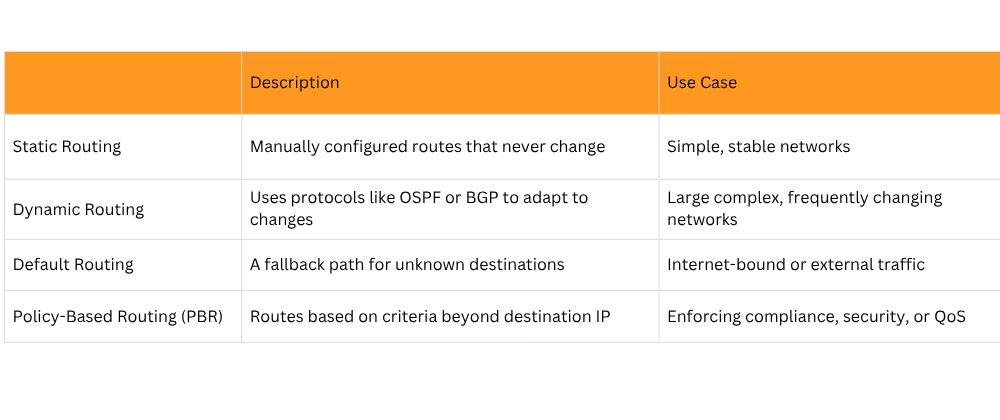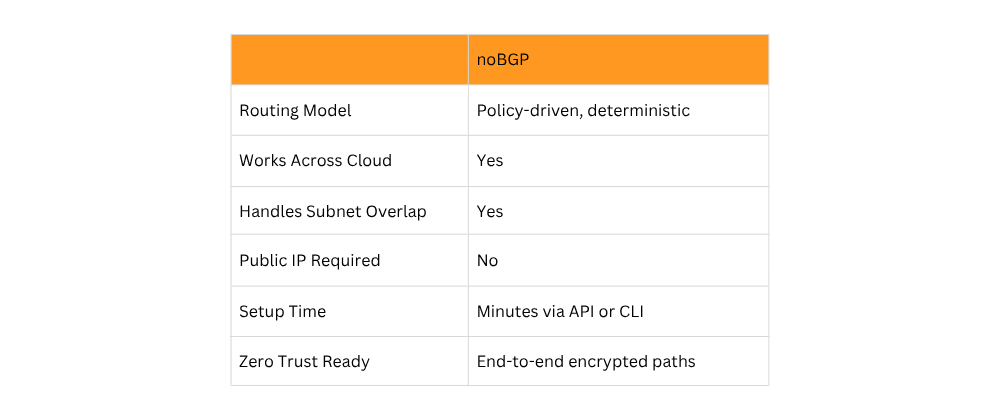What Is Deterministic Routing?
Deterministic routing is a routing approach where the path a packet takes through the network is predefined, predictable, and repeatable. Unlike traditional routing protocols, where decisions are based on changing network states, deterministic routing ensures that given the same source and destination, the data always follows the same policy-defined path—every time.
This concept is increasingly critical in today’s cloud architecture environments:
- Cloud-native deployments
- Kubernetes service mesh
- Microservices communication
- Enterprise compliance
- Zero Trust security architectures
In deterministic routing, you define the intent: which services or workloads should communicate, how, and under what conditions (e.g., latency, region, encryption). The network enforces that path without variation or guesswork.
What Are the 4 Types of Routing?
Traditionally, routing is categorized into four primary types:

Is OSPF Static or Dynamic Routing?
OSPF (Open Shortest Path First) is a dynamic routing protocol. It automatically calculates the shortest path to all destinations in a network using link-state algorithms. OSPF reacts to topology changes, making it well-suited for enterprise environments—but not for deterministic outcomes. Since OSPF’s decision-making depends on real-time data, it can cause unexpected path changes during outages or topology shifts.
What Are the 4 Routing Algorithms?
Routing algorithms define how routes are chosen. The main types are:
- Distance Vector: Routers share routing tables with neighbors (e.g., RIP).
- Link State: Routers map the full network to compute shortest paths (e.g., OSPF).
- Path Vector: Used by BGP, it advertises paths through ASNs, considering policy but not performance.
- Intent-Based (Deterministic): Defines desired outcomes and enforces fixed paths (e.g., noBGP).
Traditional algorithms focus on network state, while deterministic routing prioritizes policy intent.
Deterministic Routing vs. Traditional BGP

Traditional BGP was designed to route traffic across ISPs and backbone networks, not inside distributed, dynamic environments like microservices or hybrid cloud. It lacks the control and predictability modern systems demand.
Why Deterministic Routing Is Required Today
Modern infrastructure spans across:
- Cloud providers (AWS, Azure, GCP)
- Containers and Kubernetes clusters
- Distributed microservices
- Enterprise edge and remote users
Each component needs secure, private, and predictable connectivity, regardless of IP addresses or changing infrastructure. You can’t rely on BGP to keep things consistent. Deterministic routing ensures:
- Zero Trust enforcement
- Auditability and compliance
- No subnet collision risks
- Consistent performance policies
Without deterministic routing, troubleshooting becomes guesswork, and security boundaries can be breached.
noBGP: Deterministic Routing by Design
noBGP replaces the fragile and opaque nature of traditional routing with intent-based, deterministic routing.
How noBGP Works:
- Services are connected based on identity, not IP
- You define policies (e.g., “Service A connects to Service B in region X with encryption”)
- noBGP builds a deterministic, encrypted path between endpoints—across any cloud or environment
- No need for subnets, NATs, or BGP
Benefits of noBGP for Deterministic Routing

By eliminating reliance on IP-based topology and instead using service-level identities, noBGP brings true determinism to modern networking.
Final Thoughts
Deterministic routing is no longer a luxury, it’s a necessity for cloud-native, enterprise, and security-sensitive environments. As applications and teams become more distributed, traditional routing protocols like BGP, OSPF, and static rules fall short.
noBGP offers a new paradigm: predictable, encrypted, and declarative connections that follow your policies—not guesswork. Whether you’re deploying microservices across regions or enforcing compliance in a Zero Trust environment, deterministic routing is the foundation for resilient, secure communication.
Try noBGP and take control of your traffic, deterministically.
FAQ
Q: Why is deterministic routing important in cloud-native environments?
A: In cloud-native environments, consistent and secure communication across distributed workloads is critical. Deterministic routing provides predictability and control, helping teams avoid unpredictable BGP behavior, manage subnet collisions, and enforce zero trust policies across Kubernetes, microservices, and hybrid clouds.
Q: How does deterministic routing support data sovereignty?
A: Deterministic routing allows organizations to enforce data path policies that keep traffic within specific geographic or regulatory boundaries. This is essential for data sovereignty, where laws require sensitive data to stay within approved regions or jurisdictions.
Q: Can deterministic routing improve network performance?
A: Yes. Deterministic routing enables routing decisions based on performance metrics such as latency, bandwidth, and congestion. Instead of relying on best-effort BGP decisions, networks can be optimized for speed, throughput, and reliability—especially across multi-cloud or hybrid architectures.
Q: What’s the difference between deterministic routing and BGP?
A: BGP is a dynamic routing protocol that selects paths based on AS path and metrics, often resulting in unpredictable and indirect routes. Deterministic routing, by contrast, follows predefined, policy-driven paths that are consistent, secure, and intent-based—ideal for modern cloud and enterprise networks.

